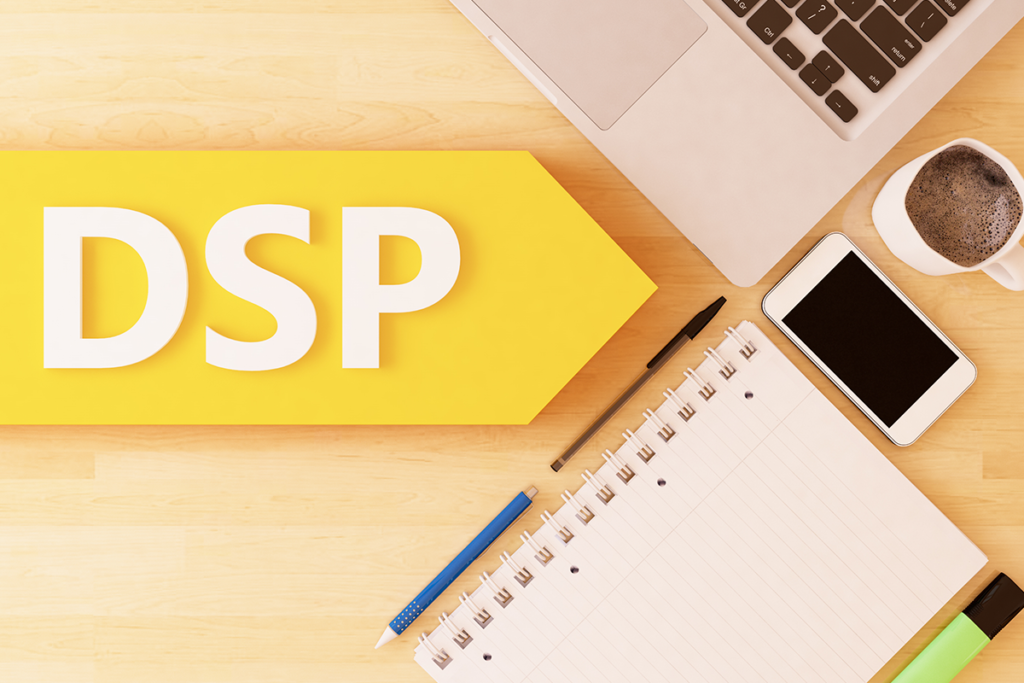The acronym DSP stands for Demand Side Platform. It is a software platform that allows mobile advertisers to buy ad inventory from a multitude of publishers in real-time. DSPs tend to be very efficient and effective tools in helping mobile marketers hit their user acquisition targets.
How does a DSP work?
They function by maintaining connections with various ad networks, exchanges and inventory sources; this allows them to have access to a considerably large amount of ad inventory. Advertisers can then use this inventory to create targeted campaigns.
Usually, a DSP has a dashboard interface that app advertisers can use to input details such as campaign information including: campaign name, start/end dates, KPI’s, targeting, bidding, creatives as well as attribution tracker links. While many DSPs have a myriad of different selections and inputs for advertisers to play around with, the aforementioned are the base foundations to create and run a mobile ad campaign.

Most DSPs run campaigns on either a CPM (Cost per Mille) or CPI (Cost per Install) basis. The former is a method whereby advertisers are charged per every 1000 impressions of their ads, and the latter is when advertisers are charged per every user acquired. The CPI cost model has proven to be very popular as advertisers are more likely to reduce budget waste on uninterested audiences, and directly end up paying for each user that installs and opens their app for the first time.
After creating a campaign, the most important DSP page will be the “Reporting” or “Analytics” page, whereby you can follow the performance of your campaigns through metrics such as impressions, clicks, installs, post-install events and revenue metrics. All this information is stored and categorized based on the tracking link you provide.

What are the benefits of using a DSP?
Increased Reach
DSPs give advertisers access to a large amount of ad inventory, which means they can reach a wider audience. Most DSPs aggregate publishers from around the globe, meaning they often have traffic for every geo-location and for every app category.
Increased Targeting
DSPs allow advertisers to target their campaigns more effectively; some platforms happen to have information pertaining to app-users of certain segments that can offer advertisers unique information to tailor their campaigns to their customers. For example, Amazon Audience platform has hands-on audience data on customers unique to Amazon. Facebook can allow you to target customers based on behavioral segmentation, whether they like a certain TV show or if they subscribe to a certain school of thought for instance.
Increased Efficiency
DSPs allow advertisers to buy ad inventory in real-time, which means they can optimize their campaigns on the fly. Most DSPs also offer advertisers with dedicated account management on top of their AI-optimizing features, meaning users rarely need to use the platform and have specialists maintaining and tweaking their campaigns for them based on prescribed KPIs.
Increased ROI
DSPs can help advertisers to achieve a higher return on investment (ROI). Through auto-optimization and smart bidding techniques, DSPs are able to weed out poor performing publishers and spotlighting high performers that bring in desired events, such as purchases. In the long run, ad campaigns remain healthy and are shown to audiences that are proven to respond positively. Advertisers, consequently, end up with reduced costs per user acquisition and increased ROI.

How to Use DSPs Effectively
If you’re new to using a Demand Side Platform (DSP), there are a few things you should know in order to get the most out of it. Here are a few tips:
1. Understand your objectives
Before you start using a DSP, it’s important that you have a clear understanding of your advertising objectives. What are you trying to achieve with your campaign? What are your target demographics? What is your budget? Once you have a good understanding of your objectives, you can start to look for a DSP that will best fit your needs. You will need to input your KPIs and targeting into the DSP dashboard. Your campaign will be optimized accordingly.
2. Choose the right DSP
Not all DSPs are created equal. Some are better suited for certain types of campaigns and GEOs than others. It’s important that you do your research and find a DSP that will work well for your specific needs. Rule of thumb is to opt for aggregators that have amassed a huge inventory in order to reduce the need for creating multiple campaigns with multiple DSPs. AppSamurai is a one-stop shop ad platform that has partnered with all the major DSPs around the globe, making it a perfect starting point for any marketer. For more information, sign up to AppSamurai’s dashboard and a dedicated manager will support you from there.
3. Make sure you’re targeting the right audiences
One of the most important aspects of using a DSP is targeting the right audience. If you’re not targeting the right people, your campaign is not likely to succeed and will be highly inefficient. Make sure you take the time to understand your target audience and create targeted campaigns accordingly. Make use of the targeting options DSPs offer you as every iota of information you provide is an optimization opportunity for the dashboard to be more effective.
4. Test, and then test again
Before you launch your campaign, it’s important to test it out. Run a few test campaigns and see how they perform. This will help you fine-tune your campaign and make sure it’s as effective as possible. You can try A/B testing with different creatives to ensure that you’re putting out the right message for your target audiences. Many DSPs and ad platforms, including AppSamurai, offer to run test campaigns with smaller budgets to gauge campaign effectiveness and performances.
5. Monitor your campaign closely
Once your campaign is live, it’s important to monitor it closely. Keep an eye on your metrics and make changes as necessary, or inform your dedicated account manager accordingly. This will help you ensure that your campaign maintains a healthy performance throughout its lifetime.
By following these tips, you can ensure that you’re using your DSP in the most effective way possible.

Conclusion
As mentioned earlier, creating campaigns on multiple DSPs can turn into a bit of a chore, let alone monitoring campaigns on 3-5 different platforms. With AppSamurai, you need only create one campaign and you will have access to the inventories of all the big DSPs on the planet, with all your data collated in one place for easy access. More than 1400 advertisers have achieved their growth goals with the San Francisco-based ad platform already, visit the AppSamurai website and hit your user acquisition goals now.



